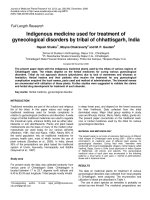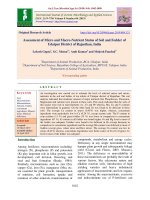Population status of sugarcane leaf hopper, pyrilla perpusilla (Walk.) and its natural enemies at Kabirdham district of Chhattisgarh, India
Bạn đang xem bản rút gọn của tài liệu. Xem và tải ngay bản đầy đủ của tài liệu tại đây (148.23 KB, 6 trang )
������������������������������������������������������������������������������������������������������������������������������������������������������������������������������������������������������������������������������������������������������������������������������������������������������������������������������������������������������������������������������������������������������������������������������������������������������������������������������������������������������������������������������������������������������������������������������������������������������������������������������������������������������������������������������������������������������������������������������������������������������������������������������������������������������������������������������������������������������������������������������������������������������������������������������������������������������������������������������������������������������������������������������������������������������������������������������������������������������������������������������������������������������������������������������������������������������������������������������������������������������������������������������������������������������������������������������������������������������������������������������������������������������������������������������������������������������������������������������������������������������������������������������������������������������������������������������������������������������������������������������������������������������������������������������������������������������������������������������������������������������������������������������������������������������������������������������������������������������������������������������������������������������������������������������������������������������������������������������������������������������������������������������������������������������������������������������������������������������������������������������������������������������������������������������������������������������������������������������������������������������������������������������������������������������������������������������������������������������������������������������������������������������������������������������������������������������������������������������������������������������������������������������������������������������������������������������������������������������������������������������������������������������������������������������������������������������������������������������������������������������������������������������������������������������������������������������������������������������������������������������������������������������������������������������������������������������������������������������������������������������������������������������������������������������������������������������������������������������������������������������������������������������������������������������������������������������������������������������������������������������������������������������������������������������������������������������������������������������������������������������������������������������������������������������������������������������������������������������������������������������������������������������������������������������������������������������������������������������������������������������������������������������������������������������������������������������������������������������������������������������������������������������������������������������������������������������������������������������������������������������������������������������������������������������������������������������������������������������������������������������������������������������������������������������������������������������������������������������������������������������������������������������������������������������������������������������������������������������������������������������������������������������������������������������������������������������������������������������������������������������������������������������������������������������������������������������������������������������������������������������������������������������������������������������������������������������������������������������������������������������������������������������������������������������������������������������������������������������������������������������������������������������������������������������������������������������������������������������������������������������������������������������������������������������������������������������������������������������������������������������������������������������������������������������������������������������������������������������������������������������������������������������������������������������������������������������������������������������������������������������������������������������������������������������������������������������������������������������������������������������������������������������������������������������������������������������������������������������������������������������������������������������������������������������������������������������������������������������������������������������������������������������������������������������������������������������������������������������������������������������������������������������������������������������������������������������������������������������������������������������������������������������������������������������������������������������������������������������������������������������������������������������������������������������������������������������������������������������������������������������������������������������������������������������������������������������������������������������������������������������������������������������������������������������������������������������������������������������������������������������������������������������������������������������������������������������������������������������������������������������������������������������������������������������������������������������������������������������������������������������������������������������������������������������������������������������������������������������������������������������������������������������������������������������������������������������������������������������������������������������������������������������������������������������������������������������������������������������������������������������������������������������������������������������������������������������������������������������������������������������������������������������������������������������������������������������������������������������������������������������������������������������������������������������������������������������������������������������������������������������������������������������������������������������������������������������������������������������������������������������������������������������������������������������������������������������������������������������������������������������������������������������������������������������������������������������������������������������������������������������������������������������������������������������������������������������������������������������������������������������������������������������������������������������������������������������������������������������������������������������������������������������������������������������������������������������������������������������������������������������������������������������������������������������������������������������������������������������������������������������������������������������������������������������������������������������������������������������������������������������������������������������������������������������������������������������������������������������������������������������������������������������������������������������������������������������������������������������������������������������������������������������������������������������������������������������������������������������������������������������������������������������������������������������������������������������������������������������������������������������������������������������������������������������������������������������������������������������������������������������������������������������������������������������������������������������������������������������������������������������������������������������������������������������������������������������������������������������������������������������������������������������������������������������������������������������������������������������������������������������������������������������������������������������������������������������������������������������������������������������������������������������������������������������������������������������������������������������������������������������������������������������������������������������������������������������������������������������������������������������������������������������������������������������������������������������������������������������������������������������������������������������������������������������������������������������������������������������������������������������������������������������������������������������������������������������������������������������������������������������������������������������������������������������������������������������������������������������������������������������������������������������������������������������������������������������������������������������������������������������������������������������������������������������������������������������������������������������������������������������������������������������������������������������������������������������������������������������������������������������������������������������������������������������������������������������������������������������������������������������������������������������������������������������������������������������������������������������������������������������������������������������������������������������������������������������������������������������������������������������������������������������������������������������������������������������������������������������������������������������������������������������������������������������������������������������������������������������������������������������������������������������������������������������������������������������������������������������������������������������������������������������������������������������������������������������������������������������������������������������������������������������������������������������������������������������������������������������������������������������������������������������������������������������������������������������������������������������������������������������������������������������������������������������������������������������������������������������������������������������������������������������������������������������������������������������������������������������������������������������������������������������������������������������������������������������������������������������������������������������������������������������������������������������������������������������������������������������������������������������������������������������������������������������������������������������������������������������������������������������������������������������������������������������������������������������������������������������������������������������������������������������������������������������������������������������������������������������������������������������������������������������������������������������������������������������������������������������������������������������������������������������������������������maximum parasitization 16.31 per at second
fortnight of October (Table 2). Similar finding
were found by Oblisami et al., (1969) who
isolated M. anisopliae from P. perpusilla
proved pathogenic to another species of
Pyrilla. Varma et al., (1977) observed
nymphal mortality caused by fungi in AugustNovember. A comparative symptom of
infection by M. anisopliae was seen on
Pyrilla. Asre et al., (1983) reported that the
effectiveness of natural enemies for the
control of P. perpusilla on sugarcane. The
entomopathogenic fungi M. anisopliae was
caused septicemia on Pyrilla. Varma and
Singh (1987) used M. anisopliae as microbial
pesticide against leafhopper. On the basis of
pooled mean the Pyrilla population was first
appeared in first fortnight of July with 1.14
eggs, 0.06 nymphs and 0.05 adults leaf-1 and
gradually increasing and reached maximum
with 8.13 eggs, 28.16 nymphs and 5.17 adults
leaf-1 at first fortnight of October. The
maximum parasitization by T. Pyrillae was
noticed during second fortnight of December
with 44.16 per cent and ento-pathogenic
fungus M. anisopliaewas high during the
second fortnight of October with 11.37 per
cent (Table1 and 2).
Committee Dr. D. K. Rana, professor,
Department of Entomology, College of
Agriculture, IGKV, Raipurand my Co-major
Advisory Dr. V. K. Soni, Assistant professor,
S K College of Agriculture & Research
Station Kawardha.
References
Anonymous, 2015a. Forth Advance Estimates
of production of Food grains for 201415. Agricultural statistics Division,
Directorate of Economics & Statistics,
Department
of
Agriculture
&
Cooperation, Government of India, New
Delhi, p.12
Anonymous, 2015b. Indian Institute of
Sugarcane Research, Lucknow, Uttar
Pradesh, India. Newsletter, 21(1):7
Anonymous, 2015c. Annual report. Indian
Institute of Sugarcane Research,
Lucknow, Uttar Pradesh, India, p. 30
Anonymous, 2017.Kharif Progress report,
Deputy Directorate of Agriculture.
Government
of
Chhattisgarh,
Kabirdham, Pp. 21-23
Asre, R., Gupta, P. K. and Pawar, A. D. 1983.
Control of sugarcane Pyrilla by its
natural enemies. Indian Farming,
33(6):37-38.
Chaudhary, J. P., Kaushik, S. K.,Singh,R. and
Mrig, K. K. 1987.Role of natural
enemies in the suppression of sugarcane
leafhopper, Pyrilla perpusilla (Walker)
FAO.Plant Protection Bulletin, 35(1):
15-19.
Chaudhary, M. A. and Ansari. N. A. 1988.
Insect pests of sugarcane in Pakistan.
Prog. Farm, 8(4): 10-18.
Gupta, B. D. and Avasthi, P. N. 1957.
Observations on a new beetle pest of
sugarcane crop in Bihar. Indian Sug.,
7:587-594.
Isaac, P. V. 1937. Information on pests of
sugarcane in India from published
received from Provinces and state
Acknowledgement
The first author expresses his heartfelt
gratitude towards Chairman of my Advisory
254
Int.J.Curr.Microbiol.App.Sci (2018) 7(3): 250-255
governments. Indian publications, pp
186.
Kumarasinghe, N.C. 1996. The sugarcane
lophopid planthopper, Pyrilla perpusilla
(Homoptera: Lophopidae): A review of
its biology, pest status and control.
BulEntomol Res., 86:485-498.
Miah, M. A. H., Qudrat-E-Khuda, A. K. M.
and Shahjahan, M.1986.The problems
of Pyrilla perpusilla and the impact of
its natural enemies. Bangladesh Journal
of Zoology. 14(1):9-13.
Mishkat, U. and Khalid. M. 2007. Population
Dynamics of Sugarcane Plant hopper,
Pyrilla perpusilla Walker (Lophopidae:
Homoptera) and its natural enemies
atDistrict MandiBaha-ud-din (Punjab).
Pak. J. Zool., 39(3): 153-157.
Oblisami,
G.,
Ramoorthi,
K.
and
Rangaswami, G. 1969. Mysore Journal
of Agriculture Science, 3(1), 86-98.
Pandey, K.P., Pandey, M.N., Mishra, V.K.,
Singh, S., Singh, D.N. and Singh, S.B.
2008.Studies on the effect of ecofriendly
bio-agent
Epiricania
melanoleuca for the control of
Sugarcane Pyrilla (Pyrilla perpusilla) in
eastern U.P. Indian Agricultural
Research Article, 23 (2): 91-95.
Patre R. S., Soni V.K., and Joshi B.
2017.Impact of the Various Abiotic
Weather Parameters on Population of
Sugarcane Leaf Hopper, Pyrilla
perpusilla
(Walk.).
Trends
in
Biosciences, 10(6):1345-1348.
Puri, K. D. and Sidhart, K. 2001.Effect of
Pyrilla epidemic on Sugarcane yield
and sucrose. Proc. 63rd Ann. Conv.
Sugar Tech. Assoc., Ind., Pp 6068.
Rajak, D. C. 2007. Colonization &
redistribution
of
Epiricania
melanoleuca Fletcher against P.
perpusilla Walker. Ann. Pl. Protec. Sci.,
15: 83-86.
Shah, H.A and Saleem, M. A. 2002.Applied
Entomology. 2nd ed. Izhar Sons
Printers, Lahore, pp 92.
Soni V.K., Patre R. S., and Joshi B.
2016.Record of Entomogenous fungi
Metarhizium anisopliae (Metschnikoff)
On Sugarcane Leafhopper, Pyrilla
perpusilla (Walk) From Chhattisgarh.
International Journal of Agriculture
Sciences, 58(8): 3165-3166.
Varma, A. and Singh, K. 1987. Metarhizium
anisopliae (Metschnikoff) Sorokin in
the management of Pyrilla perpusilla
Walker, the sugarcane leafhopper.
Entomologist Newslett, 12: 20-24.
Yadav, R. P. and Chaudhary, J. P. 1987.
Effect of temperature and relative
humidity on longevity and development
of
the
parasitoid, Tetrastichus
Pyrillae Crawford
(Hymenoptera:
Eulophidae). Insect Science and its
Application. 8 (1): 39-41.
Zubair, M., S. Ahmad, A. Rasool and Farooq.
M. A. 2006. Sugar crop research
programme report, PARC, Islamabad,
Pakistan, p. 12.
How to cite this article:
Bhupesh Joshi, V.K. Soni and Rana, D.K. 2018. Population Status of Sugarcane Leaf Hopper,
Pyrilla perpusilla (Walk.) and Its Natural Enemies at Kabirdham District of Chhattisgarh,
India. Int.J.Curr.Microbiol.App.Sci. 7(03): 250-255.
doi: />
255









